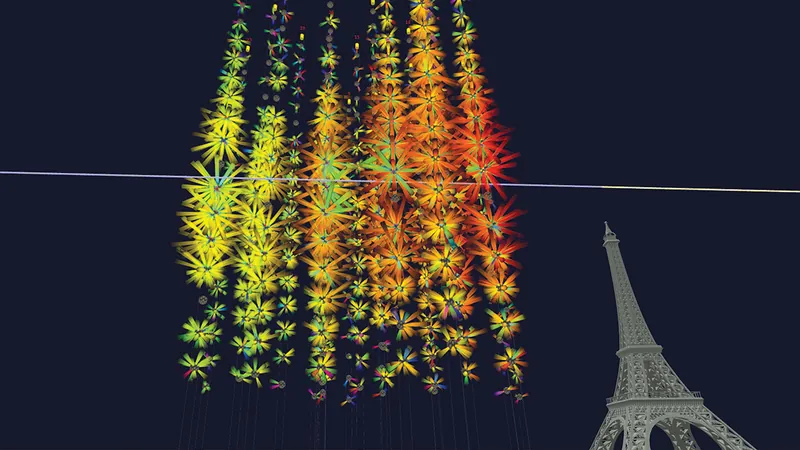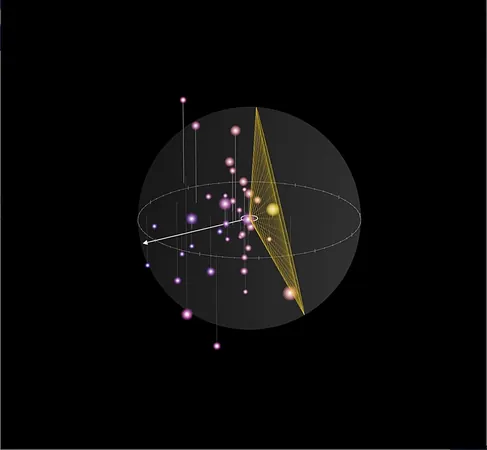
KM3NeT Detects Record-Breaking Neutrino, Opening New Cosmic Frontiers
2025-03-24
Author: Daniel
Introduction
On February 13, 2023, researchers from the KM3NeT collaboration, using strings of advanced photodetectors anchored on the seabed off Sicily, made an astonishing breakthrough: they detected the most energetic neutrino ever recorded, shattering previous high-energy records. This major discovery has sparked excitement in the scientific community, as these neutrinos could potentially originate from new cosmic accelerators, marking the possible first detection of what are known as "cosmogenic" neutrinos.
Significance of the Discovery
KM3NeT spokesperson Paul de Jong emphasized the significance of the event: "Our measurements suggest a flux that far exceeds the expectations set by both IceCube and the Pierre Auger Observatory. If this is merely a statistical fluke, it still suggests an upwards fluctuation at a confidence level of 2.2σ, which is considerable." The neutrino in question, with an impressive energy level of approximately 220 PeV, is nearly 30 times more energetic than the previous record held by IceCube.
Theoretical Predictions and Origins
Theoretical predictions for ultra-high-energy cosmic neutrinos date back to the 1960s, when astrophysicists began hypothesizing how extreme astrophysical environments could produce particles with extraordinary energies. This line of inquiry gained momentum alongside the discovery of cosmic microwave background (CMB) radiation by Arno Penzias and Robert Wilson. Cosmogenic neutrinos are theorized to arise from ultra-high-energy cosmic rays colliding with CMB photons, and while they are anticipated to have energies exceeding 100 PeV, their actual abundance remains uncertain due to the clandestine nature of cosmic ray sources.
Neutrinos and Their Detection Challenges
Neutrinos, while the second most abundant particles in the universe after photons, are notoriously difficult to detect. Their weakly interacting properties mean they can traverse immense cosmic distances without being absorbed or deflected, providing a unique glimpse into their origins and allowing researchers to explore phenomena like black-hole jets or neutron-star collisions. Such extreme cosmic events significantly challenge the limits of the Standard Model of particle physics, operating at energy levels far beyond what can be achieved in Earth-based particle accelerators.
Current Neutrino Observatories
To successfully study cosmic neutrinos, massive detectors are necessary. Currently, three notable neutrino observatories are operational: IceCube in Antarctica, KM3NeT in the Mediterranean Sea, and Baikal–GVD in Siberia's Lake Baikal. IceCube has provided remarkable findings in neutrino physics over its decade of operation, including the detection of the Glashow resonance—where a 6 PeV electron antineutrino interacts with an electron to create an on-shell W boson—and identifying neutrinos released by “active galaxies” powered by supermassive black holes. Despite its achievements, IceCube has yet to detect cosmogenic neutrinos above 10 PeV.
KM3NeT Project Overview
KM3NeT, which is still under construction, comprises two subdetectors: ORCA for studying neutrino properties, and ARCA for focusing on high-energy cosmic neutrinos and their sources. As of now, KM3NeT's ARCA section includes 21 vertical detection units, each approximately 700 meters long. Its strategic position 3.5 kilometers beneath the surface helps to minimize background interference, while its sparse arrangement over one cubic kilometer is optimized for capturing higher-energy neutrinos.
Details of the 2023 Detection
The 2023 event recorded by KM3NeT is believed to have involved a single muon produced by the interaction of a high-energy muon neutrino. This muon traveled horizontally through the ARCA detector, emitting Cherenkov light detected by about a third of its operational sensors. De Jong elaborates, "If the muon originated as a neutrino, it would have traversed around 300 km equivalent in water or rock, which is highly unlikely. It’s more probable that the muon resulted from a neutrino interaction occurring at some distance from the detector."
Future Directions and Collaborations
Future investigations are crucial to increase our understanding of ultra-high-energy neutrino origins. The KM3NeT project is rapidly advancing, with 33 out of 230 ARCA and 24 out of 115 ORCA detection units installed. Once completed, likely by the end of the decade, KM3NeT will be comparable in scale to IceCube.
Global Neutrino Telescope Network
Experts assert that with the full operation of KM3NeT and Baikal–GVD, an expansive network of three similarly sized neutrino telescopes around the globe will enhance the likelihood of discovering new neutrino sources, especially those from previously unexplored regions of the sky. "Having these three telescopes will provide nearly uniform sensitivity across the entire sky, significantly bolstering the detection of faint signals," stated Mauricio Bustamante, a theoretical astroparticle physicist at the Niels Bohr Institute.
Conclusion
This groundbreaking achievement is just the beginning, potentially reshaping our understanding of cosmic phenomena and the mysterious origins of high-energy neutrinos. The quest to unravel these cosmic enigmas continues, promising to unlock deeper insights into the universe.



 Brasil (PT)
Brasil (PT)
 Canada (EN)
Canada (EN)
 Chile (ES)
Chile (ES)
 Česko (CS)
Česko (CS)
 대한민국 (KO)
대한민국 (KO)
 España (ES)
España (ES)
 France (FR)
France (FR)
 Hong Kong (EN)
Hong Kong (EN)
 Italia (IT)
Italia (IT)
 日本 (JA)
日本 (JA)
 Magyarország (HU)
Magyarország (HU)
 Norge (NO)
Norge (NO)
 Polska (PL)
Polska (PL)
 Schweiz (DE)
Schweiz (DE)
 Singapore (EN)
Singapore (EN)
 Sverige (SV)
Sverige (SV)
 Suomi (FI)
Suomi (FI)
 Türkiye (TR)
Türkiye (TR)
 الإمارات العربية المتحدة (AR)
الإمارات العربية المتحدة (AR)